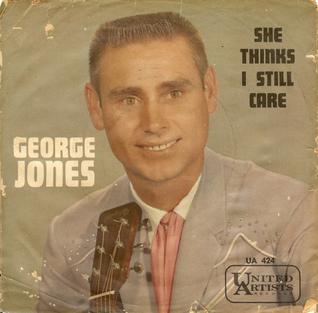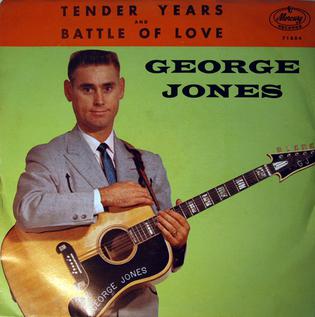
Rockabilly is the earliest style of rock and roll music. It dates back to the early 1950s in the United States, especially the South. As a genre it blends the sound of Western musical styles such as country with that of rhythm and blues, leading to what is considered "classic" rock and roll. Some have also described it as a blend of bluegrass with rock and roll. The term "rockabilly" itself is a portmanteau of "rock" and "hillbilly", the latter a reference to the country music that contributed strongly to the style. Other important influences on rockabilly include western swing, boogie-woogie, jump blues, and electric blues.

George Glenn Jones was an American country musician, singer, and songwriter. He achieved international fame for his long list of hit records, including his best-known song "He Stopped Loving Her Today", as well as his distinctive voice and phrasing. For the last two decades of his life, Jones was frequently referred to as the greatest living country singer. Country music scholar Bill Malone writes, "For the two or three minutes consumed by a song, Jones immerses himself so completely in its lyrics, and in the mood it conveys, that the listener can scarcely avoid becoming similarly involved." The shape of his nose and facial features earned Jones the nickname "The Possum". Jones has been called "The Rolls-Royce of Country Music" and had more than 160 chart singles to his name from 1955 until his death in 2013.

Starday Records was an American record label producing traditional country music during the 1950s and 1960s.

One Woman Man is an album by American country music artist George Jones, released on February 28, 1989 on Epic Records.

I Wish Tonight Would Never End is an album by American country music artist George Jones. It was released in 1963 on the United Artists record label.

George Jones Salutes Hank Williams is the 1960 country music studio album released in May 1960 by George Jones. The album was the ninth studio LP release, and was recorded in one session. The album has been reissued multiple times since its release, including the tracks being reused on many compilations.

Grand Ole Opry's New Star is the debut studio album released by George Jones in November 1956 with Starday Records. Produced by Jones' manager Pappy Daily, the album was recorded during early sessions in 1954, throughout 1955, and other sessions in 1956. It is also the first album to be released on the Starday label, a label only four years old.

The albums discography of American country artist, George Jones contains 80 studio albums, 132 compilation albums, three live albums, ten video albums and seven box sets. Of his studio albums, 69 are solo releases while 11 are collaborative releases. In 1956, Jones's debut studio LP was issued on Starday Records titled, Grand Ole Opry's New Star. The label only issued one studio effort, but would release a series of compilation. On Mercury Records, Jones released six studio LP's including Country Church Time (1959) and George Jones Salutes Hank Williams (1960). He switched to the United Artists label in 1962, where he released 13 studio LP's. Among these was a collaborative LP with Melba Montgomery called What's in Our Hearts (1963), which was his first to chart the Billboard Top Country Albums survey. He moved to Musicor in 1965. Among the label's studio LP's was I'm a People (1966), which reached the top of the Billboard country survey. Musicor also issued his first collaborative studio album with Gene Pitney, which made the Billboard country LP's chart and the Billboard 200.

"Why Baby Why" is a country music song co-written and originally recorded by George Jones. Released in late 1955 on Starday Records and produced by Starday co-founder and Jones' manager Pappy Daily, it peaked at 4 on the Billboard country charts that year. It was Jones' first chart single, following several unsuccessful singles released during the prior year on Starday.

"She Thinks I Still Care" is a country song written by Dickey Lee and Steve Duffy. The song was recorded by multiple artists, including George Jones, Connie Francis, Anne Murray, Elvis Presley and Patty Loveless.

"Tender Years" is a song written by American country music artist George Jones and Darrell Edwards. It became Jones' second #1 country hit.

Lawton Williams was an American country music singer and songwriter.
Blue & Lonesome is a compilation album by American country music artist George Jones released in 1964 on the Mercury Records label.

The singles discography of American country artist, George Jones, contains 182 singles. Of the total, 136 were released with Jones as the solo artist. In addition, 31 were issued with Jones being part of a collaboration. Thirdly, eight singles were issued with Jones being part of a featured act. Fourthly, seven released were promotional singles. Additionally, 14 songs that are not released as singles are included that made any major chart. Finally, 21 music videos which were first issued as singles are also listed. Jones had his first chart success in 1955 with several top ten Billboard Hot Country Songs singles: "Why Baby Why", "What Am I Worth" and "You Gotta Be My Baby". After several more top ten releases, "White Lightning" became his first to top the Billboard country chart. Along with "Who Shot Sam", both singles were also his first to make the Hot 100 charts.
"Just One More" is a 1956 country music song by American artist George Jones. It was released as a single on Starday Records in 1956 reached #3 on the Billboard country singles chart. The song is often featured on his early compilation albums and was one of the most successful of his self-penned songs.
"What Am I Worth" is a 1956 country music song released by George Jones, co-written by Jones and Darrell Edwards. The song was released on January 14, 1956 and was one of the fourteen songs included on Jones' debut album with Starday Records in 1957.
"Don't Stop the Music" is a song written and recorded by George Jones. It was his first single release on Mercury-Starday and peaked at #10 on the country singles chart in early 1957.
"Too Much Water" is a song written by George Jones and Sonny James. Jones released it as a single on the short-lived Mercury-Starday label in 1957, and it became a hit, peaking at No. 13 on the charts. Like most of Jones's singles to this point, "Too Much Water" was an up tempo honky tonk number in the Ernest Tubb-Hank Williams tradition, although with a slight rockabilly edge. The song was included on the 1957 LP 14 Top Country Favorites.
"Out of Control" is a song by George Jones. It was released as a single on Mercury Records in 1960.
Live at Dancetown U.S.A. is a live album by American country music artist George Jones. It was recorded in 1965 but was not released until 1987.










